ALLIGATOR
BEHAVIOR page 2c: SOCIAL SIGNALS AND BELLOWING 3 1 2 4 5 6 7 8 9 10
This
page was born 12/27/2003. Rickubis designed it. (such as
it
is.) Last update: 11/26/2012
Images
and contents on this page copyright © 2001, 2012 Richard M.
Dashnau
Alligators,
although they are ectothermic and also equipped with a small
brain, exhibit
a surprising diversity in their responses to their environment
and to each
other. They
are for more complex than mere animated logs or 12-foot-long
eating machines. This group of pages show some
of what I've been able to
see in the years I've been
volunteering (September of 2001 thru March of 2020) at Brazos
Bend State
Park.
March
16, 2003THE
SUN--wasn't out much this morning. I got to the park about
8:00am, and
I walked around wondering where all the alligators were.
As I set
up the tripod and video
camera, I looked and listened for any activity.
I thought I heard the "gloop" of an American Bittern, and I
found one where
the sound came from. As I was filming him walking and preening
(but NOT
glooping. Grrrr! Of course not, he was close enough to
hear.); some
alligators started bellowing not far from me. The heck with
the Bittern!
(Just for a while. Bittern fans please
refrain from flaming me.) I hurried
down the trail until I found him. A HUGE male was bellowing
(but about
50 yards away), and about 10 feet to the left and parallel to
him, a smaller
(probably female) alligator was bellowing with him. I'll be
reviewing the
video footage to see if this is audible at all. As I filmed, I
ran out
of tape, and so attempted a clip with the C-700.
I was able to clean up
the sound, and increase the volume on this clip. As time
allows, I'll see
if I can use any of the footage I shot with my camcorder.
Until then, here
(flv
video, 565kb) is
a clip of the male alligator in the RICKUBISCAM
this week. Aside from these two, other alligators were seen
bellowing at
various spots throughout the park. Alligators were
everywhere,
and I saw
more bitterns, but none tried to sing for me. Later the
sun came
out and the day turned out to be one of those great ones.
Well, actually
any
day where I can see and hear a large
alligator bellow is a great one.
-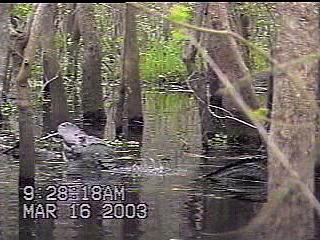 -
-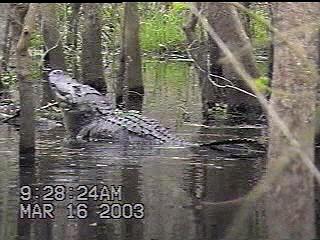 -
-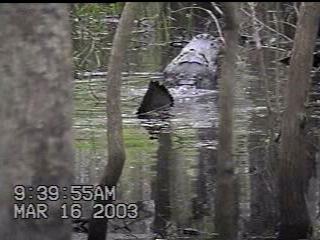 -
-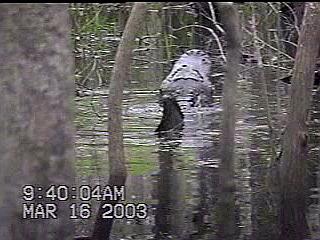 -
-
BELLOW AND WATERDANCE
BIG ONE
REARS
UP
REARS UP AGAIN
WATERDANCE AGAIN
I made
digital video files from the footage I took with the camcorder. As
I thought,
the sound quality of the clips was lessened by the distance of the
alligators
from me. I cleaned up the audio
tracks, and amplified them a little, so
that the bellowing was clearer. Although the bellowing is loud,
the background
noise against the microphone (wind, etc.) makes it hard to hear.
I
apologize
for the need for this adjustment of the original footage.
The four
pictures above are frames from the video. After I took the first
short
movie, I moved behind him between his bouts
of bellowing. I was trying
to get a better position. I was lucky to be able to get this
between the
trees. The first two images ( WATERDANCE, REARS UP ) are from CLIP
1 (flv video 1198kb);
and the second two images (UP AGAIN, DANCE AGAIN)
are from CLIP
2 (flv video
485kb). The bellow, as can be seen, is a cyclic series
of movements
and sounds. Notice how both sets
of pictures show the alligator in
almost the same postures.
April
13, 2003Today
was one of those days where everything seemed to be moving around
the park.
Snakes (particularly Broadbanded Water Snakes) were seen in many
places.
I saw six
or seven myself! But, this week I'm going to talk about
alligators (some surprise, right?), and the behavior known as a
"headslap".
I've been watching one large male for some time, mostly
because he happens
to be in the area I watch over. This is the same male that has had
the
scarring, and damage to his head and legs that I've shown here. He
also
seems to have one eye
impaired.
This
morning, he started at his usual early spot, and he stayed there
until
around 9:45. Then, he moved to the island area of Elm Lake, almost
directly
across from his "early spot".
This was about 50 yards from me.
As I watched him (with a video camera), he started posturing. That
is,
he started arching his tail and lifting his head. (see DO NOT
MESS, below;
or the
clip here flv
video 852kb).
Next, after some slow tail swishing, he did his headslap (see
SLAP-HEAD
UP, SLAP-HEAD DOWN, below, or the clip here
flv
video 820kb). (compare this with
two other headslaps that I've
shown on these pages, Alligator
Page
5, Alligator
Page
6). In all three, there was what seemed to be a short
"grunt" just
before the headslap. . (unfortunately,
technical difficulties have severely
degraded the sound quality of these new clips. I've cleaned them
up the
best I could. They were almost inaudible due to static for some
reason.)
Immediately after the headslap, another alligator began bellowing
from
the other side of the wild rice in front of "my" alligator.
This,
in turn, caused "my" alligator to begin an aggressive
bellowing posture
(see TIME TO KICK below, or the clip here
flv
video 864kb). Then he bellowed once, and when he was
answered (again
from behind the rice), he began "tail swishing" but
this was not the more
leisurely "display" tail swish. This rapid tail movement propelled
him
forward, and he gave an answering bellow as he was moving.
Observe
in the clip how belligerent
he seems, as he pushes his way into the rice.
I expected to hear some commotion, but there was no violence
evident from
within the rice. After about 15 minutes, the "scarred one"
leisurely
swam back out, and that was the end of it.
-----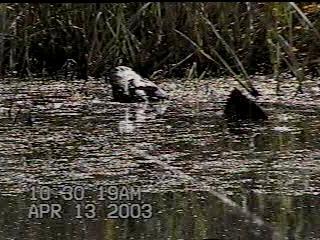 -
- 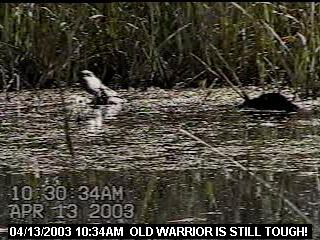 ---
---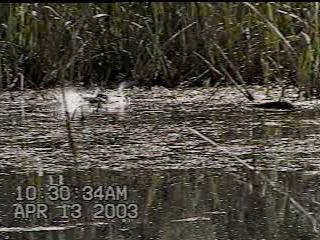 ---
---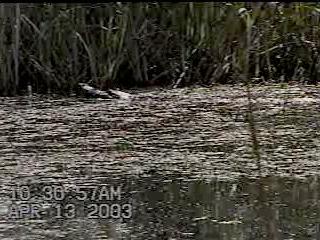 -
-
DO
NOT
MESS WITH ME
SLAP--HEAD UP
SLAP--HEAD DOWN
TIME TO
KICK SOME 'GATOR BUTT!
There
is a VERY interesting and informative work; SOCIAL SIGNALS OF
ADULT AMERICAN
ALLIGATORS, by Garrick, Lang and Herzog (a bulletin of the
American Museum
of Natural
History, issued May 25, 1978. ) Among the social signals
listed is headslapping. The authors list a number of
different
possible situations for headslapping. There are also several
additional
signals (vocalizations; audible noises made with the body--such as
bubbles;
and movements) which can alter the intent or information conveyed.
The
only concept I'll mention at this time is this:
"known dominant animals
headslap more frequently than subdominants" (page 177). From what
I've
observed, I believe this male to be the dominant animal for this
corner
of the lake. By the
way, it's a good possibility that the other two clips
I've shown before were of the same alligator. In any case, they
were a
large male that was inside of this "territory".
Pretty
complex behavior for what some people think are a "big dumb
lizard".
April
19, 2003Today,
Earth Day was celebrated at the park. As part of my contribution
to the
effort, I was signed up to lead an "alligator hike" at 2:00 pm. I
was able
to get out to Elm Lake at
about 11:30. As I was passing the last pier,
I heard another headslap from near the same area that I filmed
last weekend.
I approached a pod of baby alligators (about 14 lined up on a log)
and
their mother in the water right at the trail intersection. Just as
I got
there, and was about six feet from the mother, it took a
"bellowing" posture,
and gave one short, low bellow. Almost straight
across was
a male alligator (of pretty good size), and I thought it was the
same male
as last week. However, I checked on the lower side of the trail,
near the
downstream end of the culvert into
Pilant Lake, and *there* was the "Old
Warrior" (so it obviously wasn't him on the by the islands in Elm
Lake)
As I was interpreting for the group of visitors in that area
(between the
babies and
aggressive mother; the "showy" male; and the old warrior, there
was a lot going on, hence the group of people) (also, DON'T get me
started
talking about alligators, heh, heh) an alligator
smaller than the
protective female (by at least a 1.5 feet) approached her from the
center
of the water, moving straight in. It paused for a few minutes,
then slowly
continued in the same straight
line. The female moved out to meet this
alligator. She gave one low, bubbly "GROAK!", and the smaller
alligator
stopped immediately. Then, it turned and slowly moved off.
I've seen
females
make this sound at larger males that seemed to be trying to court
them, and after the sound, the males would lose interest. I
suspect that
the smaller alligator was a male that was approaching
the female with amorous
intentions. I don't believe that the babies alligators on the log
(and
the few in the water) were that attractive as prey to bring the
smaller
alligator in on such a straight
course.
After
this little incident, I described the "headslap" and associated
situation
and posture, and then talked about bellowing. I described the
bellowing
posture , and as I did, I considered
all the signaling that had been going
on, and decided to check on the "Old Warrior" again, since I
thought he
might respond to these displays and challenges. I had just gotten
in front
of him
when he attained the position I'd just described (see FULL LENGTH,
below. This image is linked to a 640x 480 image), and began
bellowing!
Was that cool, or WHAT? Take my word for it.
It was!
Of course,
Rick (yes, that's me) was going to be too busy to carry his
video
camera around, so of course he didn't have it with him.The middle
image
below is cropped from the original
photo I shot. (Alas! My Olympus
C-700 has developed problems, and has been sent in for repair. I
hope I
can get it fixed soon. Until then I have to use my backup camera.
)
--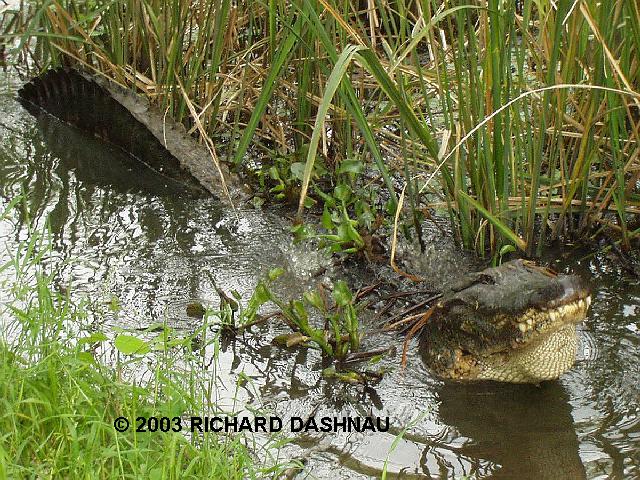 -
-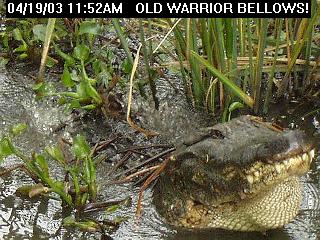 -
-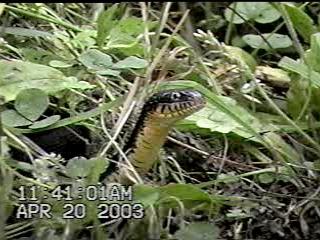
TTHE
OLD WARRIOR--FULL LENGTH
CLOSE UP
WHAT'S
UP?
Considering
that for the last few weeks, all we've seen this alligator do is
lay on
the shore and look ill, I was very pleased to see him still
active.
April
27, 2003Today,
I was at the end of Elm Lake by 8:30 A.M.. When I got there, there
was
a large male down in Pilant Lake, surrounded--at distances between
12 to
30 feet--by five or six
smaller alligators. As I watched for about 3 hours
(while interpreting for people passing by) I saw this large male
foraging
among the weeds. I had the video camera trained on him most of the
time.
The male would occasionally lay very still, then without warning
he'd lift
his head and upper body about a foot from the water, and do a
sideways
diving grab. I never got to see what he'd
catch. I couldn't leave my camera
on all this time, and it seemed that as soon as I'd turn it off,
he'd strike.
Also, he'd occasionally do the "sideways prey herding" technique
I've described
before
(see my Alligators
at
Brazos Bend State Park Page 6 ), and use
his
body to form a small area against the shore. Then, he'd do a
leisurely
prey-grabbing move. At about 9:30,one of the smaller
alligators crossed
the trail. (see GORGEOUS, below and flv
video
1176 kb). At about 12:00 he formed the "bellow
position".
I called some nearby visitors over and turned my camera towards
him.
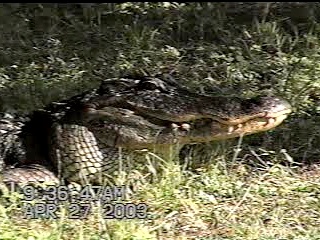 -
- -
-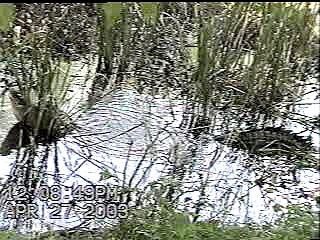 -
-
GORGEOUS!
TOGETHER
I'M TOP REPTILE!
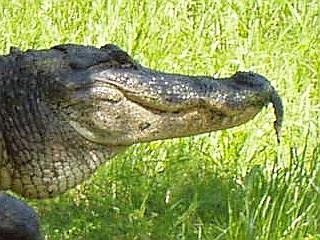 ----
----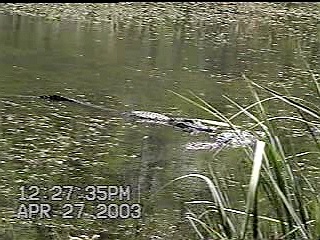
GOT SOME
FLOSS?
YOU AVAILABLE?
Then,
without the customary bobbing, his back started to vibrate (I
thought I
could feel my body shake!) and then he gave one short bellow (see
TOP REPTILE,
above; or flv
video 634 kb
) .
As you can see, I missed the very beginning of his bellow.
I like this clip because one can hear how impressed the park
visitors were.
A couple of them were sure it sounded like a Harley
starting. He
got up on shore near what I assumed was a female (she was in the
water
when I'd first gotten there, but got out fairly soon.)(See
TOGETHER above).
He stayed there for about
15 or 20 minutes before reentering the water.
Finally, he moved a little further down, moved into the trees, and
crossed
the trail on his way to Elm Lake. The picture above (FLOSS)
shows
him as he's just left the Elm Lake side of the trail (see the
clip-- flv
video
451 kb ). From time to time until this crossing, I'd
seen something
stuck in the front of his mouth. It appeared to be
a snake at one time...but
I can't be sure. It seemed to have scales, and to be elongated;
but it
could have been a fish. As he crossed the trail, I could see
this
hanging from the very front of
his jaw (see GOT FLOSS? above). When
he got into Elm Lake, he moved slowly across to the islands.
However, a
smaller alligator (which I think is female--see YOU
AVAILABLE?,
above;
or, watch the clip flv
video
1470 kb ) swam from nearby straight towards him.
She gently
nuzzled him, but he didn't seem to respond. Or, perhaps, she just
swam
over and said
"Hey...you've got something nasty caught between your teeth.",
and he was too cool to acknowledge his embarrassment. In any
case,
he was not responsive, and she swam off. It
appeared to me that she
was half his size.
One
further note: The female I talked about last week attacked a
5-foot
alligator that afternoon. She'd been very defensive all weekend.
Today,
she was not visible near her young at all, although they were
still there
(although I couldn't count 15).
May 04,
2003Today,
there were alligators moving all over the park! Today's
RICKUBISCAM
shows a large male (about 10 feet long) at the edge of Elm
Lake.
This one was between
two other ones (one about 6 feet long, the other about
9 feet long) that were completely out of the water. I only saw
this one
do one long gape...not the open-mouth heat regulating posture,
but more
like a long yawn. The image below (YAWN PART 2) shows his mouth
gaping
even wider!
-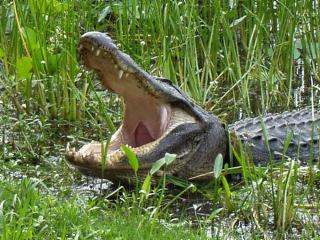 -
-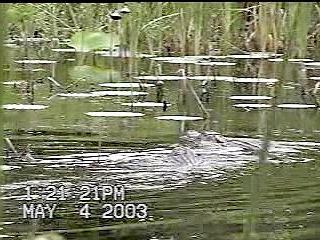 -
-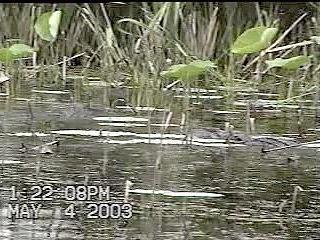 -
-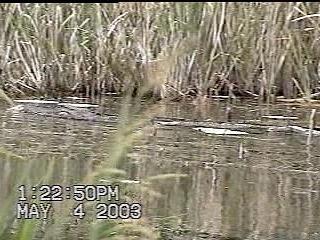
YAWN
PART
2
NO MEANS NO!
MY BOYFRIEND'S BACK!
LET'S
DANCE, TOUGH GUY!
ADDED
5/06-- Earlier on May 4, I was
down
near pier 2 or 3 on Elm Lake. As I was walking, I heard an
unmistakable
sound. It was a sort of deep, gurgling croak. I've heard this
sound at
other times. At these times, an alligator, which I assumed to be
female
(in some cases, this alligator would be much smaller than the
alligator
it was speaking to) would make this noise when
approached by a male (I
assumed) that was attempting to mate with it. Most times,
the approaching
alligator would stop almost immediately, and stop any pursuit or
further
closing
movement. Today, however, the amorous male didn't take no
for an answer. The female continued her "croaking" as the male
pursued.
(see NO MEANS NO, above, or flv
video
clip1(1811 kb)
and flv
video
clip2(1655 kb)).
I watched though my
video camera as she turned and finally went into the grass.
That
wasn't the end, though. If you watch the third video clip( flv
video
clip3(1718 kb) ;
near the middle of the clip,
note what happens in the right foreground. A larger
male makes
an appearance (which I didn't see at first since I was looking
through
my video camera--I wish I
knew where he came from), and sneaks up on the
first pursuing male (see MY BOYFRIEND'S BACK, above).
Notice
the sudden turbulence as the first pursuer realizes that HE is
being
pursued.
What followed then was an interesting chase that went towards the
higher
numbered piers for about 5 minutes (see LET'S DANCE, above, or flv
video
clip4(2188 kb)).
They were
moving fast enough
to require me to walk rapidly to get ahead of them. Finally,
the
bigger male just slowed down and moved towards one of the islands,
as the
smaller one continued
swimming a little further, though not as quickly.
The chase went past two of the piers. I was once again
impressed
by how non-violent most alligator interaction is. Yes,
there
was implied
threat, but everything proceeded at a certain pace,
and no alligators were actually attacked. This event has
given me
something to think about though. Did the female's calls alert the
larger
male? Is this the purpose of the call? That is, is this sound not
directed that the pursuing male--to warn it off; but instead a
call to
the dominant male in the area? On further thought, it this
seems unlikely.
The female's calls might have just happened to alert the larger
male. I
could also be wrong in assuming that the chasing male is the
dominant male
in that part of the lake
(that is, it might not be his territory, either).
Interesting, isn't it?
And, this page
shows alligators at the park, on land, near various landmarks at the park.
Go back to my main alligator
page, Alligators
Go
back to my home page, Welcome
to
rickubis.com
Go
back
to the See the
World
page.
 -
- -
- -
- -
-















